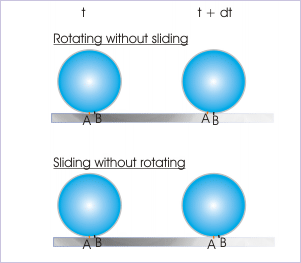| << Chapter < Page | Chapter >> Page > |
Rolling motion is a composite motion, in which a body undergoes both translational and rotational motion. The wheel of a car, for example, rotates about a moving axis and at the same time translates a net distance. Rolling motion being superposition of two types of motion, presents a different context of motion, which needs visualization from different perspectives. Importantly, different parts of the wheel are moving with different velocities, depending on their relative positions with respect to the center of mass or the point of contact with the surface.
In this module, we shall examine rolling motion of a circular disc along a straight line. This study shall be valid for all other circular or spherical bodies capable of rolling such as sphere, cylinder, ring etc.
In order to bring out characterizing aspects of rolling motion, we consider a disk, which is rolling without sliding (simply referred as rolling) smoothly on a horizontal surface such that its center of mass translates with a velocity " " in x-direction.
“Rolling without sliding” means that the point on the rim in contact with the surface changes continuously as the disk rotates while translating ahead. If point "A" is in contact at a given time "t", then another neighboring point "B" takes up the position immediately after, say, at a time instant, t+dt. In case the disk slides while translating, the point of contact remains same at the two time instants. The two cases are illustrated in the figure here.
Rolling without sliding

The terms “Rolling without sliding”, "pure rolling" or simply "rolling" refer to same composite motion along a straight line.
When rolling motion is seen from a frame of reference attached to the center of rolling disk i.e. a frame of reference which is moving with a velocity, " ", the particles constituting the disk undergo rotation with an angular velocity,ω, without translation. The axis of rotation is fixed in the moving frame of reference. As such, rolling is a pure rotation in the moving frame of reference attached to the center of disk.
In this frame of reference (attached to the rolling disk), a particle on the rim of the disk rotates through the same distance in a given time as distance covered by the moving frame of reference in x-direction. If the particle in contact with the surface describes an angle 2π in rolling motion, then both the particle and axis of rotation (also center of mass) travels a distance 2πr. However, they describe different paths. The particle on the rim travels an arc as seen from the moving reference, whereas the center of mass or attached frame of reference travels along a straight line as seen from the ground.
In general, if the moving frame of reference travels a distance "x" in time "t", then the particle at the contact point also rotates through the same distance along the arc of the perimeter of rolling object. This is true for a particle on any position on the rim of the disk. The figure here captures the two situations corresponding to start and end of the observations. From the geometry shown in the figure,

Notification Switch
Would you like to follow the 'Physics for k-12' conversation and receive update notifications?